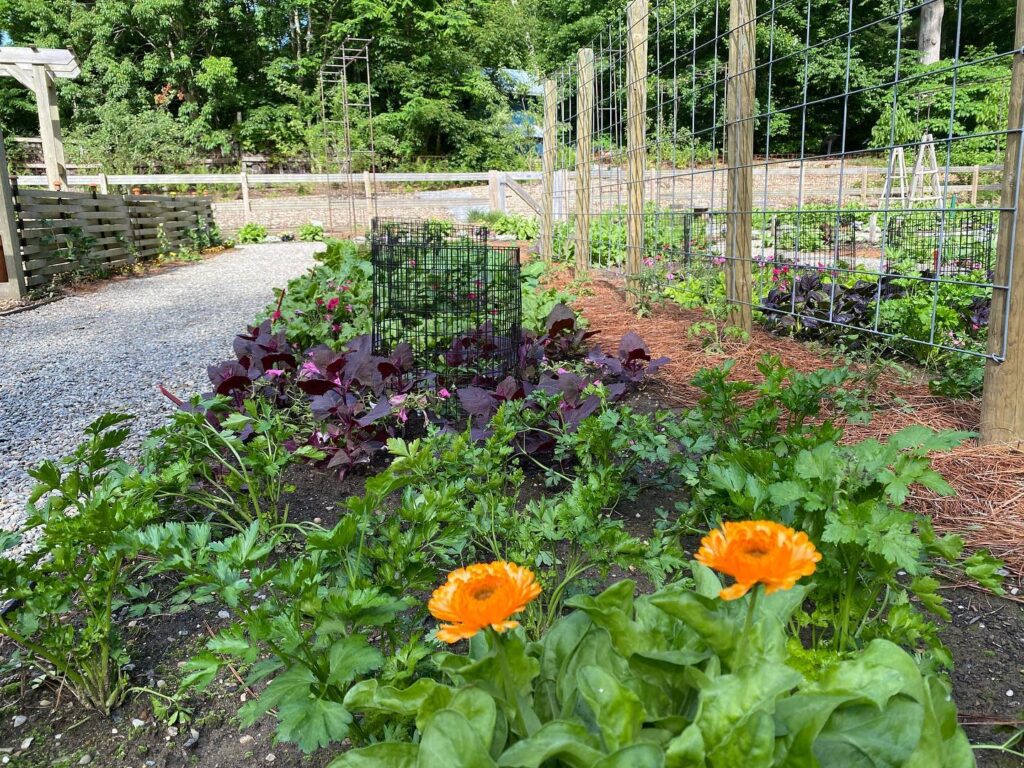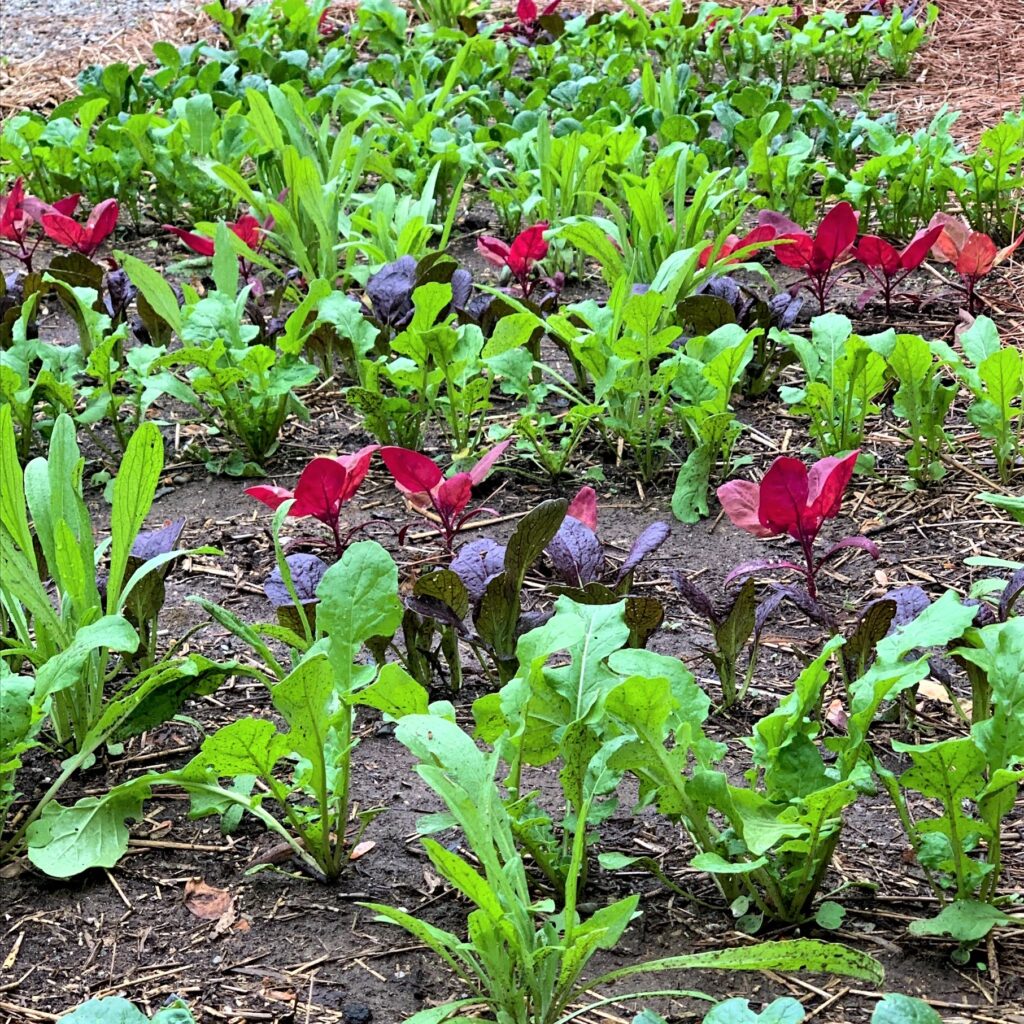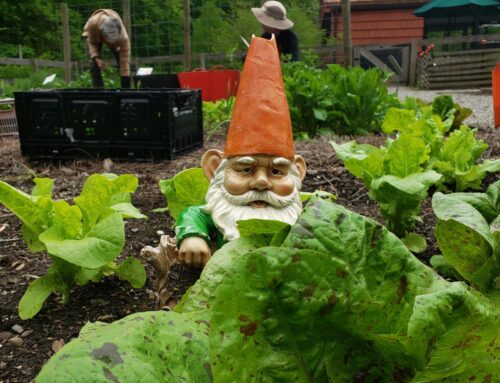Color is a powerful form of communication. Just stop by Lucille’s Garden, and you too will know how much color matters! This blog will look at this year’s garden plans for spring, summer, and fall through Lucille’s Garden’s annual theme, “Color is Life.”
Color plays a vitally important role in the world in which we live. Color can sway thinking, change actions, and cause reactions. It can irritate or soothe your eyes, raise your blood pressure, or suppress your appetite.
Join us in Lucille’s Garden over the next three seasons, and you will find yourself in a sea of color coming amidst our 3,750 seedlings and 250 different crop varieties.
Let me be more specific – if you are facing the garden with the Education Center at your back, entering the gate on the left side, you will be surrounded by warm, soft pastel tones (pinks, yellows, and oranges). Then, as you stroll towards the back left of the garden, you will see tropical plants displaying vibrant green, red, and yellow and dramatic stems and leaves. Next, you’ll pass into an area of the garden with soft pastel cool colors of blue and purple.
Upon first glance, you might conclude we are showcasing flowers in Lucille’s Garden. And we are! Yet, still, the flowers serve a purpose – to feed the many pollinators who visit the garden. So let’s look at how color affects the pollinators we seek to attract to the garden. This list reflects the best information we have now – but we continue to learn more about pollinators, and the way they interact with their environment, all the time. This is a good place to get started:
- Butterflies prefer red flowers that have a landing platform.
- Bees are attracted to pink, yellow, and blue distinctly-marked flowers, of which many reflect a bull’s eye pattern of ultraviolet light.
- Flies, who have poorer vision, prefer saucer-shaped white flowers.
- Night-feeding moths are attracted to heavy fragrance, but because color is not visible by night, moth-pollinated flowers are usually pale green or white.
- Bats choose large, pale, and fragrant flowers.
- Beetles go for brightly colored flowers with usually an unpleasant or carrion scent.
- Hummingbirds choose red, tubular, hanging flowers with abundant nectar.
Flowers with stripes and dots or other bright markings act like “runway lights” for airplanes. They help guide the pollinators into the part of the plant that has the sweet nectar, the reward for pollen transfer.
Amidst all the beautiful blooms, you’ll also recognize the vegetables you know and love, though their colors may differ from those you’re used to at your dinner table. A few examples include Dark Purple Opal Basil, Chinese Pink Celery, Dwarf Blue Curled Kale, Japanese Pink Mizuna, Jing Orange Okra, Round Black Radish, Strawberry Spinach, Thornburn’s Terracotta Tomato, and Lemon Cuke Cucumber.
The same food in different colors and shades brings new antioxidants and sometimes a higher value of a vitamin or mineral. For example, red tomatoes provide the most phosphorus of all tomato colors, green tomatoes offer the highest amount of vitamin C of all tomato colors, and orange tomatoes provide significantly more vitamin A than other colors. Golden beets have substantially higher amounts of vitamin C than red beets. All cauliflower is rich in vitamin C and K, but purple cauliflower has the antioxidant anthocyanin, used to help prevent cell mutation and cancer.
Let’s look at how specific colors of fruits and vegetables affect our health. This list does not constitute medical advice; as always, consult with your doctor before making changes to your diet. Tyler Arboretum cannot advise on your health – though we can confirm that eating the rainbow is delicious!
- Red – protects the heart and reduces the risk of developing atherosclerosis, hypertension, and high cholesterol.
- Blue and Purple – help prevent stroke, cancer, and heart disease. These colors are important for memory and help promote healthy aging. In addition, they protect urinary tract health and regulate healthy digestion.
- Orange and Yellow – are packed with nutrients known to protect the nervous system, promote eye health, and prevent heart disease. They also play an important role in maintaining skin health, boosting the immune system, and helping build strong bones.
- Green – protects eye health, lowers the risk of developing age-related macular degeneration, protects from cancer and high levels of bad cholesterol, regulates digestion, and improves immune system functioning.
- White – reduces bad cholesterol, lowers high blood pressure, provides an immune-boosting effect on the body, and minimizes the risk of colon, prostate, and breast cancer.
My mother used to put what we were having for dinner on a plate on the countertop, then step midway across the kitchen, and then either exclaim, “That’s it!” or “We need orange,” or some nights, it was “red” or even “purple.” My mother was a painter and quilter who had a great sense of color. Little did I know that she was not only creating a pleasant pallet for the eyes but also great nutrition for the body. Thanks, Mom, your lessons are not lost on me now.
The growing season is fast upon us. So, for the next three seasons, stop by and see us to gain inspiration for your own garden, learn to get more nutrition in each bite, and find balm for your soul.









